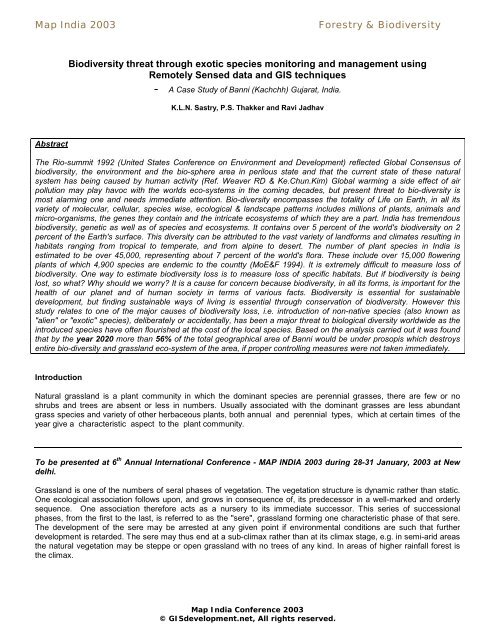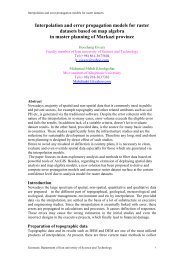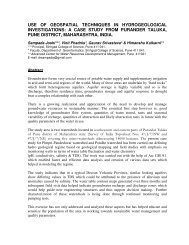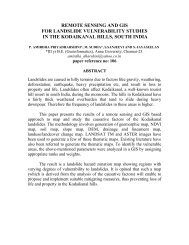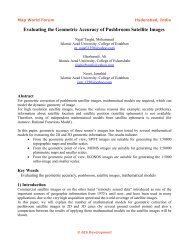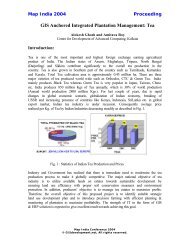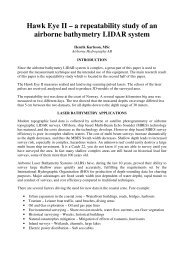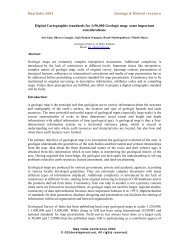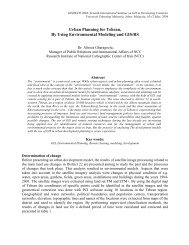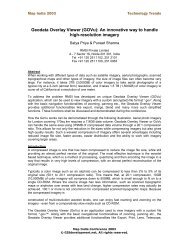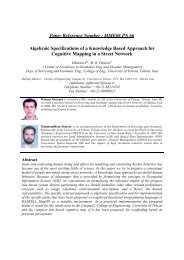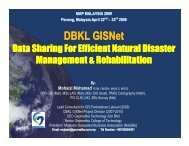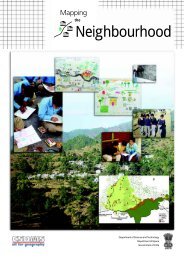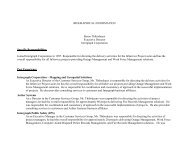A Case Study of Banni (Kachchh) Gujarat, India.
A Case Study of Banni (Kachchh) Gujarat, India.
A Case Study of Banni (Kachchh) Gujarat, India.
You also want an ePaper? Increase the reach of your titles
YUMPU automatically turns print PDFs into web optimized ePapers that Google loves.
Map <strong>India</strong> 2003<br />
Forestry & Biodiversity<br />
Biodiversity threat through exotic species monitoring and management using<br />
Remotely Sensed data and GIS techniques<br />
- A <strong>Case</strong> <strong>Study</strong> <strong>of</strong> <strong>Banni</strong> (<strong>Kachchh</strong>) <strong>Gujarat</strong>, <strong>India</strong>.<br />
K.L.N. Sastry, P.S. Thakker and Ravi Jadhav<br />
Abstract<br />
The Rio-summit 1992 (United States Conference on Environment and Development) reflected Global Consensus <strong>of</strong><br />
biodiversity, the environment and the bio-sphere area in perilous state and that the current state <strong>of</strong> these natural<br />
system has being caused by human activity (Ref. Weaver RD & Ke.Chun.Kim) Global warming a side effect <strong>of</strong> air<br />
pollution may play havoc with the worlds eco-systems in the coming decades, but present threat to bio-diversity is<br />
most alarming one and needs immediate attention. Bio-diversity encompasses the totality <strong>of</strong> Life on Earth, in all its<br />
variety <strong>of</strong> molecular, cellular, species wise, ecological & landscape patterns includes millions <strong>of</strong> plants, animals and<br />
micro-organisms, the genes they contain and the intricate ecosystems <strong>of</strong> which they are a part. <strong>India</strong> has tremendous<br />
biodiversity, genetic as well as <strong>of</strong> species and ecosystems. It contains over 5 percent <strong>of</strong> the world's biodiversity on 2<br />
percent <strong>of</strong> the Earth's surface. This diversity can be attributed to the vast variety <strong>of</strong> landforms and climates resulting in<br />
habitats ranging from tropical to temperate, and from alpine to desert. The number <strong>of</strong> plant species in <strong>India</strong> is<br />
estimated to be over 45,000, representing about 7 percent <strong>of</strong> the world's flora. These include over 15,000 flowering<br />
plants <strong>of</strong> which 4,900 species are endemic to the countty (MoE&F 1994). It is extremely difficult to measure loss <strong>of</strong><br />
biodiversity. One way to estimate biodiversity loss is to measure loss <strong>of</strong> specific habitats. But if biodiversity is being<br />
lost, so what? Why should we worry? It is a cause for concern because biodiversity, in all its forms, is important for the<br />
health <strong>of</strong> our planet and <strong>of</strong> human society in terms <strong>of</strong> various facts. Biodiversity is essential for sustainable<br />
development, but finding sustainable ways <strong>of</strong> living is essential through conservation <strong>of</strong> biodiversity. However this<br />
study relates to one <strong>of</strong> the major causes <strong>of</strong> biodiversity loss, i.e. introduction <strong>of</strong> non-native species (also known as<br />
"alien" or "exotic" species), deliberately or accidentally, has been a major threat to biological diversity worldwide as the<br />
introduced species have <strong>of</strong>ten flourished at the cost <strong>of</strong> the local species. Based on the analysis carried out it was found<br />
that by the year 2020 more than 56% <strong>of</strong> the total geographical area <strong>of</strong> <strong>Banni</strong> would be under prosopis which destroys<br />
entire bio-diversity and grassland eco-system <strong>of</strong> the area, if proper controlling measures were not taken immediately.<br />
Introduction<br />
Natural grassland is a plant community in which the dominant species are perennial grasses, there are few or no<br />
shrubs and trees are absent or less in numbers. Usually associated with the dominant grasses are less abundant<br />
grass species and variety <strong>of</strong> other herbaceous plants, both annual and perennial types, which at certain times <strong>of</strong> the<br />
year give a characteristic aspect to the plant community.<br />
To be presented at 6 th Annual International Conference - MAP INDIA 2003 during 28-31 January, 2003 at New<br />
delhi.<br />
Grassland is one <strong>of</strong> the numbers <strong>of</strong> seral phases <strong>of</strong> vegetation. The vegetation structure is dynamic rather than static.<br />
One ecological association follows upon, and grows in consequence <strong>of</strong>, its predecessor in a well-marked and orderly<br />
sequence. One association therefore acts as a nursery to its immediate successor. This series <strong>of</strong> successional<br />
phases, from the first to the last, is referred to as the "sere", grassland forming one characteristic phase <strong>of</strong> that sere.<br />
The development <strong>of</strong> the sere may be arrested at any given point if environmental conditions are such that further<br />
development is retarded. The sere may thus end at a sub-climax rather than at its climax stage, e.g. in semi-arid areas<br />
the natural vegetation may be steppe or open grassland with no trees <strong>of</strong> any kind. In areas <strong>of</strong> higher rainfall forest is<br />
the climax.<br />
Map <strong>India</strong> Conference 2003<br />
© GISdevelopment.net, All rights reserved.
Map <strong>India</strong> 2003<br />
Forestry & Biodiversity<br />
In regions <strong>of</strong> high rainfall, the tendency to revert toward forest is particularly marked and confronts the pioneer with<br />
difficult problems <strong>of</strong> stock and pasture management. Continued under-stocking will allow a normal reversion, first to<br />
weeds, and then to shrubs and scrubs, habitual overgrazing will tend to weaken the sward so that the establishment <strong>of</strong><br />
weeds is made easier.<br />
Many <strong>of</strong> the large grassland areas, such as the prairies and plains <strong>of</strong> North America, the pampas <strong>of</strong> South<br />
America, the steppes <strong>of</strong> Asia and the Veld <strong>of</strong> Africa are believed to be <strong>of</strong> great antiquity and are climax<br />
formations determined by soil and climate. Other grasslands are <strong>of</strong> more recent origin and have replaced forests<br />
that have been destroyed mainly by cutting and fire; these have been maintained largely through grazing animals.<br />
True grasslands exist in most part <strong>of</strong> the world where the rainfall is not sufficient to produce thick forest, and yet<br />
sufficiently high to prevent the creation <strong>of</strong> a desert. The great grasslands once covered nearly half <strong>of</strong> the earth's land<br />
surface, from the rolling Prairies <strong>of</strong> North America to the great Savannahs <strong>of</strong> Africa and the vast Steppes <strong>of</strong> Eurasia.<br />
Generally speaking, grassland have few, scattered, small sized trees to break the drying winds. Most <strong>of</strong> these areas<br />
go through periodic drought conditions. As a result, majority <strong>of</strong> plants <strong>of</strong> these regions lives more " in " the soil than<br />
above it. Just under the surface there is a tangled map <strong>of</strong> roots and rhizomes. Some grassroots grow down to the<br />
depths <strong>of</strong> a meter into the soil, while the tap roots <strong>of</strong> other s<strong>of</strong>t stemmed plants may penetrate to five meter in their<br />
search for water and nourishment.<br />
Importance <strong>of</strong> Grassland.<br />
When we talk about grassland, we have to first consider the main component, that goes to form the bulk <strong>of</strong> the<br />
grassland, that is grass. Of all, the grasses are the most important to man. All our food stuff like corn, wheat, oats,<br />
rye, barley, and rice, sugarcane are grasses. Bamboo's are also grasses. Although, the great importance <strong>of</strong><br />
grasslands lies in providing sustenance, grasses also serve humanity in other ways. Grass may be used for<br />
building homes and furniture (walls, thatch, matting, brooms) lawns, sports fields and as components <strong>of</strong> some<br />
cosmetics and medicines.<br />
Grassland provides crucial grazing land and pastures for the domestic and migrated livestock, which forms important<br />
livelihood for majority <strong>of</strong> the population <strong>of</strong> <strong>Banni</strong> and surrounding districts. The milching capacity and overall health<br />
<strong>of</strong> the cattle, is an indicator <strong>of</strong> grassland quality. From these grasslands large quantity <strong>of</strong> forage grass is collected<br />
annually by cutting, and storing it in grass godowns for the droughts. However, free grazing can deteriorate these<br />
grasslands, for which only controlled " rotational grazing " is useful.<br />
Introduced Species :<br />
Introduction <strong>of</strong> non-native species (also known as "alien" or "exotic" species), deliberately or accidentally, has been a<br />
major threat to biological diversity worldwide as the introduced species have <strong>of</strong>ten flourished at the cost <strong>of</strong> the local<br />
species. <strong>India</strong>'s Biodiversity, too, has been affected by introduction <strong>of</strong> alien species. Several exotic animals and plants<br />
introduced in the Andaman and Nicobar Islands are posing a threat to the local species <strong>of</strong> fauna and flora. Animal<br />
husbandry, an occupation <strong>of</strong> majority <strong>of</strong> <strong>India</strong>n farmers, is directly dependent upon grassland for sustenance and it<br />
contributes a significant 5 to 6% towards <strong>India</strong>'s national income (The State <strong>of</strong> <strong>India</strong>'s Environment 1984-85).<br />
<strong>Study</strong> Area<br />
The <strong>Banni</strong> area, as the name signifies, is a ‘<strong>Banni</strong> hui’ (in Hindi) meaning made up land formed by the detritus brought<br />
down and deposited predominantly by the Indus river, which was reported to flow through the Great Rann in the past.<br />
The great and the little ranns <strong>of</strong> <strong>Kachchh</strong> were the old arms <strong>of</strong> the sea in the old geological period. Due to the eruption<br />
and formation <strong>of</strong> the Allah Bund near the Kori Creek, the lands in the Great and Little ranns got blocked up and were<br />
filled up by the deposits brought down by the Indus river (Source: Notes from Animal Husbandry <strong>of</strong> Agriculture,<br />
<strong>Gujarat</strong>). Once upon a time <strong>Banni</strong> was considered the largest grassland <strong>of</strong> its kind in Asia, but has fallen upon sad<br />
times in the last decade. The <strong>Banni</strong> area under the present investigation extends over Bhuj and Nakhtrana Talukas <strong>of</strong><br />
<strong>Kachchh</strong> Districts. It is situated on the northern border <strong>of</strong> <strong>Kachchh</strong> mainland, consisting <strong>of</strong> 45 villages. The actual area<br />
Map <strong>India</strong> Conference 2003<br />
© GISdevelopment.net, All rights reserved.
Map <strong>India</strong> 2003<br />
Forestry & Biodiversity<br />
lies between North latitudes <strong>of</strong> 23 o 19' and 23 o 52' N and East longitudes <strong>of</strong> 68 o 56' to 70 o 32' E. Vegetation comprises <strong>of</strong><br />
grassland, shrubs and legumes found naturally in the <strong>Banni</strong> area. Normally the area is covered with coarse and low<br />
perennial grasses and other non-grass species present in <strong>Banni</strong> area are as follows (Source : <strong>Banni</strong> Development<br />
Office, Bhuj, <strong>Kachchh</strong>).<br />
1. Dichanthium-annulatum, (Forsk) Stapf<br />
2. Sporobolus helvolus (Trin) Thw.<br />
3. Chloris barbate, SW.<br />
4. Cenchrus biflorus, Roxb.<br />
5. Eleusine bianata<br />
6. Elysecarpus rugosus (legume), Wall<br />
7. Heylandis latebrosa (legume), DC<br />
8. Digitarea sanguinalis, Scop. Var Ciliaris Prain<br />
9. Crotolaria medicaginea, Lam.<br />
10. Indig<strong>of</strong>era sps. (Legume), Linn.<br />
11. Sida sps. (Malvaceaa) L.<br />
12. Malanocenchrus jacquemontii, J&S<br />
13. Sporobolus diander (Retz) P. Beauv<br />
14. Cenchrus setigerus, vahl<br />
15. Aristida adscensionis, L<br />
16. Aristida funiculata, Trin & Rupr<br />
17. Setaria rhachitricho, Cook<br />
18. Eragrostis minor and major, Host.<br />
19. Eragrostis trimula, Hochst.<br />
20. Cyprus rotundus, Linn(dupareate form)<br />
21. Desmostachya bipinnata (L.) Stapf<br />
22. Cyperus rotundus, Linn<br />
23. Cressa cretica (Convovulaceae), Linn<br />
24. Eragrostis bulbosa<br />
25. Kochia sps. (Polygonaceae), Roth<br />
26. Suaeda fruticosa<br />
Out <strong>of</strong> the above 26 grass species first 12 species are palatable and rest <strong>of</strong> them are salt-tolerant grasses.<br />
<strong>Banni</strong> area deterioration is linked to the increasing salinity ingress, impoverishment and illiteracy <strong>of</strong> its<br />
inhabitants, a growing human and livestock population, and invasion <strong>of</strong> prosopis juliflora, which <strong>of</strong>fers quick<br />
fuelwood, but its proliferation is dangerous for the grassland, over grazing and improper management <strong>of</strong> the<br />
land.<br />
Data used<br />
The following data was used during the course <strong>of</strong> this study<br />
1. IRS 1C/1D LISS-III data( transparencies ) <strong>of</strong> two seasons at 1:50,000<br />
2. <strong>Banni</strong> area map prepared by <strong>Banni</strong> Development Authority and WRD/CDO joint report.<br />
3. Ground truth data collection.<br />
GIS Database Design and Organisation for <strong>Banni</strong><br />
The data base for the <strong>Banni</strong> development plan has basically two components, Spatial and Non- Spatial. The<br />
Geographic Information system (GIS) package is the core <strong>of</strong> the database for handling the two sets <strong>of</strong> data. In the<br />
present study ARC/INFO GIS package has been employed as the main tool to design, Organization, storage,<br />
retrieval, analysis and generation <strong>of</strong> cartographic outputs. Non-Spatial Data basically consisting <strong>of</strong><br />
numeric/attributes in respect <strong>of</strong> Grassland type-code, Salinity range-code, composition and prosopis density<br />
class-code.<br />
Since it was required that a typical analysis had to be carried out for <strong>Banni</strong> Development Plan, as it was<br />
discussed with other participating agencies like <strong>Gujarat</strong> Institute <strong>of</strong> Desert Ecology (GUIDE), Animal Husbandry,<br />
<strong>Banni</strong> Development <strong>of</strong>fice at Bhuj. The database contents are given in TABLE – 1 .<br />
Map <strong>India</strong> Conference 2003<br />
© GISdevelopment.net, All rights reserved.
Map <strong>India</strong> 2003<br />
Forestry & Biodiversity<br />
Table – 1 : Primary and derived Themes used for <strong>Banni</strong> development plan<br />
Sr. Theme Type Primary/ Source Criteria Remarks<br />
No.<br />
Derived<br />
1 Grassland/ Polygon Primary IRS 1C/1D<br />
- -<br />
Landcover map<br />
1998-99<br />
2 <strong>Banni</strong> Polygon Primary <strong>Banni</strong> Devp.<br />
- -<br />
Boundary<br />
Office<br />
3 Roads Line Primary SOI toposheets - -<br />
and IRS 1C/1D<br />
L3 DATA<br />
4 Elevation Points Primary SOI toposheets - -<br />
& limited GPS<br />
points<br />
5 Drainage Lines Primary SOI toposheets - -<br />
6 Contours Polygons and<br />
lines<br />
Derived Elevation points - Tin and Lattice Model<br />
<strong>of</strong> ARC/INFO<br />
7 Slope Polygons Derived Elevation Points Tin and Lattice Model<br />
<strong>of</strong> ARC/INFO<br />
8 Action Plans For:<br />
8.1 Palatable<br />
Grass<br />
8.2 Mass Weeding<br />
<strong>of</strong> Prosopis<br />
Polygons Derived Landcover Map Multiparametric<br />
criterion based<br />
Analysis<br />
Polygons Derived Landcover Map Multiparametric<br />
criterion based<br />
Analysis<br />
8.3 Pure Prosopis Polygons Derived Landcover Map Multiparametric<br />
criterion based<br />
Analysis<br />
8.4 Salinity range Polygons Derived Landcover Map Criterion based<br />
Analysis<br />
8.5 Water<br />
Harvesting<br />
Polygons Derived Slope Map &<br />
Drainage<br />
Criterion based<br />
Analysis<br />
Identification &<br />
Extraction using GIS<br />
Identification and<br />
Extraction using GIS<br />
Recursive Elimination<br />
Analysis using GIS<br />
Identification <strong>of</strong><br />
fertility island <strong>of</strong><br />
Vegetation types<br />
Possible sites<br />
identified as per the<br />
discussion with<br />
experts<br />
Each <strong>of</strong> the above mentioned action plans was generated using multi – parametric criterion based analysis by<br />
GIS techniques.<br />
Methodology<br />
Looking in to the typical problems <strong>of</strong> <strong>Banni</strong> grasslands and subsequent discussions held with experts,<br />
participating agencies and also with the agencies working in <strong>Banni</strong> development activity at Bhuj, it is felt that the<br />
problems <strong>of</strong> <strong>Banni</strong> can be addressed by four major action plans which are required for implementing for <strong>Banni</strong><br />
development.<br />
They are:<br />
i. Palatable good Grasslands protection and conservation<br />
ii. Arresting Prosopis juliflora invasion into grasslands ( both Palatable and Salt tolerant )<br />
iii. Phase – wise removal <strong>of</strong> Prosopis in non – saline areas and<br />
iv. Rain water harvesting for salinity leaching and increasing grass production<br />
Map <strong>India</strong> Conference 2003<br />
© GISdevelopment.net, All rights reserved.
Map <strong>India</strong> 2003<br />
Forestry & Biodiversity<br />
The methodology flow chart is given below:<br />
Multi-temporal<br />
vegetation map<br />
from RS data<br />
<strong>Banni</strong> (west) boundary<br />
Map from conventional<br />
sources<br />
Elevation and<br />
limited GPS points<br />
Drainage pattern<br />
map from RS<br />
Data<br />
Multi-parametric<br />
criterion based<br />
analysis in GIS<br />
GIS<br />
database<br />
organizatio<br />
Identification <strong>of</strong><br />
fertility island <strong>of</strong><br />
vegetation<br />
Pure Grass<br />
patches<br />
( palateble)<br />
Pure Grass +<br />
Grass saline<br />
+ grass under<br />
tree cover<br />
Thick P.<br />
Juliflora<br />
patches + P.<br />
juliflora with<br />
grass<br />
DEM<br />
generation<br />
Soil Salinity<br />
range map<br />
Slope map<br />
Action plan<br />
for<br />
Trenching,<br />
Furrowing &<br />
Fencing for<br />
better<br />
management<br />
Action plan<br />
for Mass<br />
weeding <strong>of</strong> P.<br />
juliflora<br />
immediately<br />
after post<br />
monsoon<br />
Action plan<br />
for Phasewise<br />
removal <strong>of</strong><br />
P.juliflora in<br />
low saline<br />
plots<br />
Indication <strong>of</strong><br />
possible sites<br />
for rain<br />
water<br />
harvesting<br />
structures<br />
Overlay<br />
Fig - 01: Schematic Representation <strong>of</strong> Methodology for <strong>Banni</strong> Development Plan<br />
Map <strong>India</strong> Conference 2003<br />
© GISdevelopment.net, All rights reserved.
Map <strong>India</strong> 2003<br />
Forestry & Biodiversity<br />
Results, Discussions and Suggestions<br />
Based on the analysis carried out the following results were found.<br />
Prosopis invasion<br />
Invasion <strong>of</strong> Prosopis can be attributed to various allogenic and autogenic factors operating at spatial scales<br />
ranging from the small patch to entire landscape. Allogenic factors include climatic changes, over grazing etc.<br />
Allogenic factors operating to favor Prosopis invasion over good grasslands is an increase in the spatial and<br />
temporal heterogeneity <strong>of</strong> soil salinity, cattle droppings etc.. which promotes the invasion <strong>of</strong> Prosopis.<br />
Prosopis invasion in <strong>Banni</strong> using multi-temporal Satellite data <strong>of</strong> 1980,1985 1988 and 1998 (Normal, Drought,<br />
Normal) have been calculated. The percent <strong>of</strong> area under P.juliflora are as follows:<br />
Year Area (Ha.) %<br />
1980 37893 9.85<br />
1985 35046 9.11<br />
1988 76786 19.96<br />
1998 118675 31.23<br />
Looking at the present scenario and comparing with our own previous studies, it is very interesting to calculate the<br />
future trend <strong>of</strong> invasion in the <strong>Banni</strong> (W) area. To do the trend analysis <strong>of</strong> Prosopis invasion in <strong>Banni</strong>, <strong>Kachchh</strong>,<br />
we have considered an imperial equation, which had been validated by using 1988,1998 & 1999 Satellite data.<br />
Based on that equation we have predicted P-invasion in <strong>Banni</strong> upto 2020.The results are as follows:<br />
Year Area (ha.) %area<br />
1998 118799.40 31.2630<br />
2005 149275.78 39.2831<br />
2010 171017.48 45.0046<br />
2015 192736.38 50.7201<br />
2020 214432.71 56.4297<br />
This shows very alarming situation for <strong>Banni</strong> Grasslands. By the year 2020 more than 56% <strong>of</strong> the total<br />
geographical area <strong>of</strong> <strong>Banni</strong> would be under prosopis and destroys entire bio-diversity, and grassland eco-system<br />
<strong>of</strong> the area, if proper controlling measures were not taken immediately. One <strong>of</strong> the measures suggested was<br />
Mass weeding <strong>of</strong> Prosopis immediately after post – monsoon so as to control its invasion in new areas where<br />
good and palatable grass is growing at present. Fig-02 shows spatial distribution <strong>of</strong> areas for mass weeding <strong>of</strong><br />
P.juliflora immediately after the post-monsoon.<br />
Phase – wise removal <strong>of</strong> prosopis<br />
Looking at the stock <strong>of</strong> Prosopis in <strong>Banni</strong>, it is very essential to remove (uprooting or cut and burn with kerosene)<br />
from non – saline areas. But, removing entire Prosopis at once may cause ecological problems. So, it is<br />
suggested to remove Prosopis phase – wise (may be 1kmX1km plots) starting from matured patches to complete<br />
with in Four or Five years. Fig-03 shows priority areas for phase-wise removal <strong>of</strong> P.juliflora from pure patches <strong>of</strong><br />
prosopis and prosopis invading in good grasslands.<br />
Protecting and Controlling open Grasslands<br />
It is observed from the analysis that, if the rainfall is normal, there is a good grass growth in non–saline patches <strong>of</strong><br />
land in <strong>Banni</strong>. Because <strong>of</strong> over grazing by domestic and migrated cattle from surrounding districts and also from<br />
Rajasthan, the grass is getting exhausted before it fully grows to a particular stage. To overcome this problem it<br />
is essential to protect open (uncontrolled) grasslands to arrest the entry <strong>of</strong> cattle freely from all sides <strong>of</strong> the<br />
Map <strong>India</strong> Conference 2003<br />
© GISdevelopment.net, All rights reserved.
Map <strong>India</strong> 2003<br />
Forestry & Biodiversity<br />
patches. So, it is suggested to fence these patches. Moreover, it is required to do furrowing in these lands for<br />
moisture retaining and thereby better production in the subsequent years.<br />
Salinity ingress<br />
Trenching<br />
This is another major problem in <strong>Banni</strong>. Salinity ingress is approximately about 4% per year in the region. To<br />
control this ingress to some extent it is suggested to dig a trench around good grasslands, which helps in leaching<br />
out salinity and arrest cattle entry to some extent. Fig - 04 depicts the length <strong>of</strong> trenching and fencing required<br />
and the cost may be calculated based on local labor and material charges.<br />
Ghaduli – Santalpur<br />
It is also suggested that the road which is planned to construct between Ghaduli – Santalpur (via. Khavda –<br />
Katwndh – Dolaveera – Amrapur – Bela and Madhutra) must be completed having sluice gate opening only one<br />
side to arrest salinity ingress into <strong>Banni</strong> and other areas.<br />
Rain water harvesting<br />
Leaching out salinity atleast Five to Eight inches from the surface will help grass to grow in low – saline areas <strong>of</strong><br />
<strong>Banni</strong>. This is possible by allowing fresh water (rain water) to flow over saline areas. For this purpose rain water<br />
harvesting is necessary. So, the possible locations were suggested. However, it is very much required to study<br />
“What type <strong>of</strong> structure ?, How much capacity etc.. “ for implementation. Fig - 05 shows the topography <strong>of</strong> the<br />
area and Fig - 06 shows the status <strong>of</strong> drainage pattern in the area and suggested rainwater-harvesting structures.<br />
References<br />
Weaver RD & Ke.chun.kin Economic valuation <strong>of</strong> Bio-diversity. In Bio-diversity & Landscapes PP 255-269,<br />
Cambridge University Press.<br />
Biodiversity, CEE, 1997, Oxford University Press.<br />
Grassland Mapping & Monitoring <strong>of</strong> <strong>Banni</strong> (<strong>Kachchh</strong>) <strong>Gujarat</strong> using Remotely Sensed Data by R. N. Jadhav, M.<br />
M. Kimothi, A. K. Kandya. January 1992.<br />
Map <strong>India</strong> Conference 2003<br />
© GISdevelopment.net, All rights reserved.


